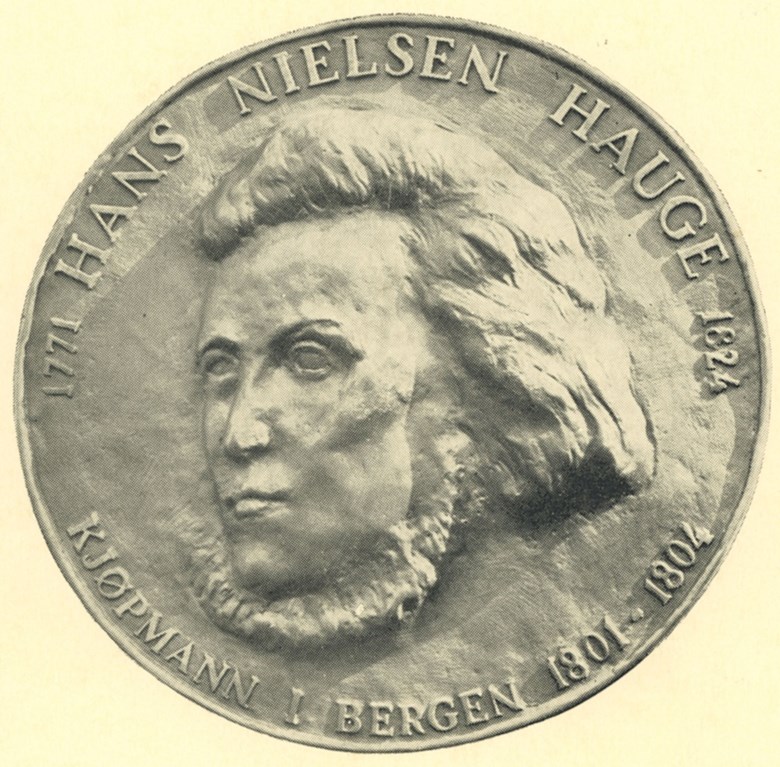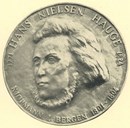At the point of Saltverkneset
The memorial is erected "by the shores of Svanøy", on the north side of the island and highly visible at the point of Saltverkneset. The memorial stone was erected in 1954 by the family, 150 years after Ole Torjussen Svanøe came to Svanøy. The stone is 3.5 metres high, with a width of about 60 centimetres. At the front, facing the bay of Svanøybukta, the year 1809 is carved. In an arch above the year it is written:
HANS NIELSEN HAUGE 1771-1824
And in an arch underneath: OLE TORJUSSEN SVANØE 1781-1859
The names and the dates form a circle with the year 1809 at the centre.
At the back it is written: Raised by the Svanøe family 1954

Hans Nielsen Hauge
Bishop Andreas Aarflot writes: "Hans Nielsen Hauge [1771-1824] emerged at a social and cultural time of unrest, where national ideas and popular currents made the societal structure of the old established autocracy creak in its foundations. Hauge's personality was marked by many contrasts. He had inherited his share of the class differences that generations before him had grown up in. At the same time, he felt close to the new currents and ideas of the times. Throughout his activities of awakening people into action, and as an industrialist and a social reformer, he contributed to speeding the process of change that had barely started at the time he was born. In the Norwegian church he became the originator of the most comprehensive renewal ever."
Hans Nielsen Hauge created a nation-wide, profound and prolonged movement, marked by spiritual awakening and material progress. Part of the explanation can be found in a network of competent co-workers around the country. Many of these later became important members of the rural community as well as members of the Storting (Parliament). One of these lived at Svanøy.

Ole Torjussen Svanøe
Ole Torjussen Svanøe, born 28 March 1778 at Helling in the valley of Hallingdal, was son of farmer Torjus Olsson and Asbjørg Torsteinsdotter Stave. He was married to Kjersti Åmundsdotter Korsbøen from Modum.
Ole met Hans Nielsen Hauge in 1801, and later became one of his closest friends. It was on Hauge's advice that Ole bought Svanøy in Kinn in 1804. He came to Svanøy at Whitsun the same year, and took Svanøe as his family name. Erik Olsen (1781-1861) from Ål accompanied him as his servant.
Ole Svanøe was an energetic and intelligent man. Besides establishing a sawmill, flourmill, shipyard, and a salt-extracting facility on his property, he was also a tradesman in Bergen. He wrote and published a number of educational pamphlets. Svanøe represented the county of Nordre Bergenhus Amt (the present county of Sogn og Fjordane) for five terms, in 1821, 1824, 1827, 1836 and 1842. In addition, he was a deputy representative in 1818 and 1833.
Ole Svanøe died on 29 December 1859 and was buried on the Svanøy graveyard.

Svanøy - a centre for the lay Hauge movement
Svanøy was a stronghold for the Hauge movement in Sunnfjord with Ole Svanøe and his son Christopher as its main leaders. People travelled to Svanøy to seek advice, comfort and help, in spiritual matters and in many other issues of a more practical nature. He travelled around in the region of Sunnfjord to preach the word of the Lord and guide people.
Tingneset in Vevring was another "haugianer" centre. Lars Jakobsson, owner in the early 19th century, was a close friend of Hauge's, and in 1830, Erik Olsen bought Tingneset, the servant boy from Ål who came to Svanøy in 1804. He was also an itinerant preacher.






